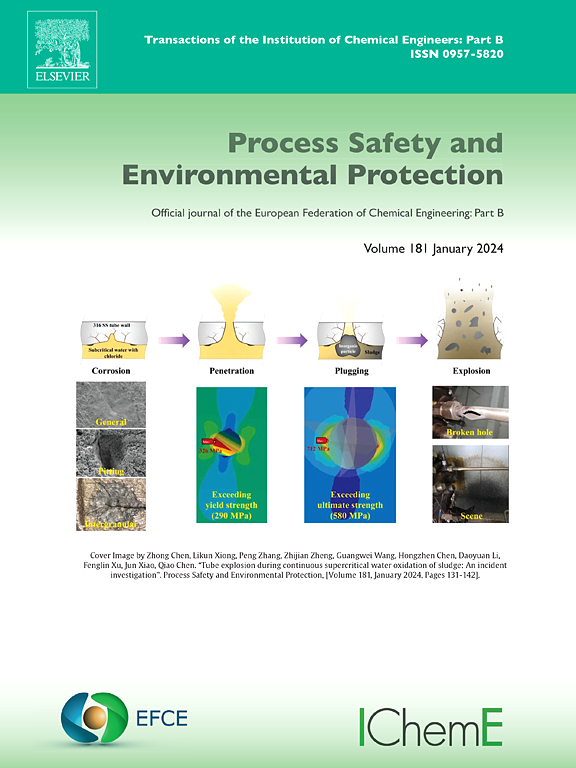Microplastics and nanoplastics across the food web: Challenges and mitigation strategies in securing human health
IF 7.8
2区 环境科学与生态学
Q1 ENGINEERING, CHEMICAL
引用次数: 0
Abstract
Microplastics (MPs, particles < 5 mm) and even smaller nanoplastics (NPs, particles < 100 nm) are ubiquitous synthetic polymer fragments predominantly derived from mismanaged plastic waste and industrial discharge breakdown. Their widespread presence in marine and terrestrial environments has raised global concern over the infiltration of MP/NPs into food chains and potential adverse impacts on food quality and human health. Organisms across aquatic and terrestrial food chains readily ingest MP/NPs. In marine systems, they are consumed by small aquatic organisms and accumulate in fish and shellfish. In contrast, in terrestrial systems, they contaminate soil and can be taken up by crops. These pathways contribute to the bioaccumulation and biomagnification of plastics within edible tissues, ultimately leading to human dietary exposure through contaminated seafood, fruits, and vegetables. Once inside living organisms, MP/NPs can compromise food quality by reducing nutritional content and triggering oxidative stress, inflammation, and cellular damage. Human intake of these particles has been associated with gastrointestinal disturbances, immune system dysfunction, endocrine disruption, and potential cancer risks. The mitigation strategies to overcome plastic pollution are introducing the advanced filtration system, detection methods, innovative water bodies clean-up technologies, banning single-use plastic, and using biodegradable and plant-based alternatives. However, critical research gaps remain in understanding the long-term effects of low-dose chronic exposure and the interactions of MP/NPs particles with other environmental stressors. This review emphasizes the urgent need for multidisciplinary investigations to fully elucidate the fate and health consequences of MP/NPs in the food web and to inform effective mitigation strategies.
整个食物网中的微塑料和纳米塑料:确保人类健康的挑战和缓解战略
微塑料(MPs,颗粒<;5 毫米)和更小的纳米塑料(NPs,颗粒<;100 nm)是普遍存在的合成聚合物碎片,主要来自管理不善的塑料废物和工业排放分解。它们在海洋和陆地环境中的广泛存在,引起了全球对中毒性生物/非毒性生物渗入食物链以及对食品质量和人类健康的潜在不利影响的关注。跨水生和陆生食物链的生物很容易摄取MP/NPs。在海洋系统中,它们被小型水生生物消耗,并在鱼类和贝类中积累。相反,在陆地系统中,它们会污染土壤,并被作物吸收。这些途径有助于塑料在可食用组织内的生物积累和生物放大,最终导致人类通过受污染的海鲜、水果和蔬菜摄入。一旦进入生物体,MP/NPs会通过降低营养成分和引发氧化应激、炎症和细胞损伤来损害食品质量。人类摄入这些颗粒与胃肠道紊乱、免疫系统功能障碍、内分泌紊乱和潜在的癌症风险有关。克服塑料污染的缓解战略是引进先进的过滤系统、检测方法、创新的水体清理技术、禁止使用一次性塑料、使用可生物降解和植物性替代品。然而,在了解低剂量慢性暴露的长期影响以及MP/NPs颗粒与其他环境应激源的相互作用方面,仍存在关键的研究空白。本综述强调迫切需要进行多学科调查,以充分阐明食物网中MP/NPs的命运和健康后果,并为有效的缓解策略提供信息。
本文章由计算机程序翻译,如有差异,请以英文原文为准。
求助全文
约1分钟内获得全文
求助全文
来源期刊

Process Safety and Environmental Protection
环境科学-工程:化工
CiteScore
11.40
自引率
15.40%
发文量
929
审稿时长
8.0 months
期刊介绍:
The Process Safety and Environmental Protection (PSEP) journal is a leading international publication that focuses on the publication of high-quality, original research papers in the field of engineering, specifically those related to the safety of industrial processes and environmental protection. The journal encourages submissions that present new developments in safety and environmental aspects, particularly those that show how research findings can be applied in process engineering design and practice.
PSEP is particularly interested in research that brings fresh perspectives to established engineering principles, identifies unsolved problems, or suggests directions for future research. The journal also values contributions that push the boundaries of traditional engineering and welcomes multidisciplinary papers.
PSEP's articles are abstracted and indexed by a range of databases and services, which helps to ensure that the journal's research is accessible and recognized in the academic and professional communities. These databases include ANTE, Chemical Abstracts, Chemical Hazards in Industry, Current Contents, Elsevier Engineering Information database, Pascal Francis, Web of Science, Scopus, Engineering Information Database EnCompass LIT (Elsevier), and INSPEC. This wide coverage facilitates the dissemination of the journal's content to a global audience interested in process safety and environmental engineering.
 求助内容:
求助内容: 应助结果提醒方式:
应助结果提醒方式:


